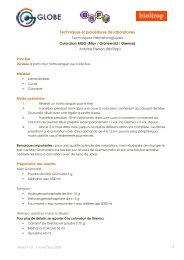For vaccine - GLOBE NETWORK
For vaccine - GLOBE NETWORK
For vaccine - GLOBE NETWORK
You also want an ePaper? Increase the reach of your titles
YUMPU automatically turns print PDFs into web optimized ePapers that Google loves.
How to determine the effectiveness<br />
of Hib and pneumococcal conjugate<br />
<strong>vaccine</strong>s in developing countries?<br />
Kim Mulholland<br />
London School of Hygiene and Tropical<br />
Medicine, and Menzies School of Health<br />
Research, Darwin
We know that pneumococcal<br />
conjugate <strong>vaccine</strong>s are effective ‐<br />
• From RCT’s<br />
– Nth California (PCV‐7, Prevnar®, Wyeth)<br />
– Gambia (PCV‐9, Wyeth)<br />
– S Africa (PCV‐9, Wyeth)<br />
• From post‐introduction surveillance<br />
– USA (PCV‐7, Prevnar®, Wyeth)<br />
– UK, Canada, Australia, etc (PCV‐7, Prevnar®,<br />
Wyeth)
But difficult questions have arisen…<br />
• Uncertain disease burden<br />
– Few data on pneumococcal disease burden in Asia<br />
– Philippines 11‐v PCV trial<br />
• No impact on clinical pneumonia<br />
• Serotype replacement<br />
– Wherever PCV’s introduced, carriage and disease<br />
due to non‐<strong>vaccine</strong> types (NVT) ↑
But difficult questions have arisen…<br />
• Uncertain disease burden<br />
– Few data on pneumococcal disease burden in Asia<br />
– Philippines 11‐v PCV trial<br />
• No impact on clinical pneumonia<br />
• Serotype replacement<br />
– Wherever PCV’s introduced, carriage and disease<br />
due to non‐<strong>vaccine</strong> types (NVT) ↑
Bohol study of PCV‐11<br />
• 12,194 infants randomized (individually) to<br />
receive PCV‐11 (Sanofi Pasteur, never<br />
licensed) or placebo at 6, 10 and 14 weeks<br />
• Radiological pneumonia<br />
– PCV‐11 – 93<br />
– Placebo – 120<br />
• Clinical pneumonia<br />
– PCV‐11 – 934<br />
– Placebo ‐ 930<br />
Vaccine efficacy 23%, N/S<br />
Vaccine efficacy 0<br />
PIDJ 2009;28:456-62
Lombok study of Hib <strong>vaccine</strong> (PRP‐T)<br />
• 55,073 infants randomized (by hamlet) to<br />
receive PRP‐T+DTP or DTP at 6, 10 and 14<br />
weeks<br />
• Radiological pneumonia (rate/1000<br />
chld.years)<br />
– PRPT – 9.4<br />
– Control– 8.9<br />
• Clinical pneumonia<br />
– PRP‐T – 380<br />
– Control ‐ 395<br />
Vaccine efficacy
But difficult questions have arisen…<br />
• Uncertain disease burden<br />
– Few data on pneumococcal disease burden in Asia<br />
– Philippines 11‐v PCV trial<br />
• No impact on clinical pneumonia<br />
• Serotype replacement<br />
– Wherever PCV’s introduced, carriage and disease<br />
due to non‐<strong>vaccine</strong> types (NVT) ↑
Invasive pneumococcal disease in Alaskan<br />
natives – under 2 years<br />
450<br />
400<br />
350<br />
300<br />
250<br />
200<br />
150<br />
all disease<br />
<strong>vaccine</strong> type<br />
non-<strong>vaccine</strong> type<br />
100<br />
50<br />
0<br />
1995-2000 2001-2003 2004-2006<br />
JAMA 2007;297:1784‐92
So the key questions are…<br />
• How to establish the effectiveness of Pnc<br />
<strong>vaccine</strong>s in settings where the contribution of<br />
Pnc to pneumonia burden is in doubt?<br />
• How to detect declining effectiveness that<br />
may be due to serotype replacement?
How to establish the effectiveness of<br />
Pnc <strong>vaccine</strong>s in settings where the<br />
impact is in doubt?<br />
• Before and after?<br />
• Case control study?<br />
• RCT?
Before and after…<br />
• Need consistent and complete case<br />
ascertainment<br />
• Outcomes:<br />
– Invasive pneumococcal disease<br />
– Pneumonia<br />
– Mortality<br />
• Problems<br />
– Viral epidemics<br />
– Changing referral patterns
Cumulative incidence per 1000 population per year, hospitalised<br />
radiologically confirmed pneumonia, by study year and age group,<br />
NT Indigenous children, April 1997 – March 2005<br />
70<br />
60<br />
1-11mths<br />
12-23mths<br />
24-59mths<br />
All children<br />
50<br />
Rate per 1000 population<br />
40<br />
30<br />
20<br />
10<br />
0<br />
Apr97 - Mar98 Apr98 - Mar99 Apr99 - Mar00 Apr00 - Mar01 Apr01 - Mar02 Apr02 - Mar03 Apr03 - Mar04 Apr04 - Mar05<br />
Study year<br />
Data courtesy of Dr Kerry‐Ann O’Grady, Menzies School of Health Research, Darwin
ARI surveillance system<br />
Viet Nam<br />
Target population:<br />
Paediatric cases admitted with ARIs: fast and/or difficulty in breathing<br />
Catchment area: 16 communes of Nha Trang city(total 27 communes)<br />
Khanh Hoa District<br />
Clinical‐epidemiological data:<br />
Demographic, clinical and management data<br />
Sample:<br />
Nasopharyngeal swab for Nucleic acid extraction<br />
Others:<br />
Chest Xray and blood sample<br />
CXR: standardized by MiASoft, Ltd. (Faringdon, UK) radiology training modules.
Number of ARI/Pneumonia cases Nha Trang:<br />
Jan 29th, 2007 to Jun 30th,2008: 1126 cases<br />
Jan 2007 Jan 2008
Seasonal Prevalence of Major Pediatric Viral Respiratory Pathogens<br />
60<br />
Positive rate (%)<br />
50<br />
40<br />
30<br />
20<br />
Rhino<br />
RSV<br />
Inf A<br />
10<br />
0<br />
2007<br />
Feb<br />
2007<br />
Mar<br />
2007<br />
April<br />
2007<br />
May<br />
2007<br />
June<br />
2007<br />
July<br />
2007<br />
Aug<br />
2007<br />
Sept<br />
2007<br />
Oct<br />
2007<br />
Nov<br />
2007<br />
Dec<br />
2008<br />
Jan<br />
N=29 53 87 88 75 136 100 82 78 44 45 64 37 112<br />
2008<br />
Feb<br />
2008<br />
Mar<br />
Slides courtesy of Dr Lay Myint, University of Nagasaki
Cumulative incidence per 1000 population per year, hospitalised<br />
radiologically confirmed pneumonia, by study year and age group,<br />
NT Indigenous children, April 1997 – March 2005<br />
70<br />
60<br />
1-11mths<br />
12-23mths<br />
24-59mths<br />
All children<br />
50<br />
Rate per 1000 population<br />
40<br />
30<br />
20<br />
10<br />
0<br />
Apr97 - Mar98 Apr98 - Mar99 Apr99 - Mar00 Apr00 - Mar01 Apr01 - Mar02 Apr02 - Mar03 Apr03 - Mar04 Apr04 - Mar05<br />
Study year<br />
Data courtesy of Dr Kerry‐Ann O’Grady, Menzies School of Health Research, Darwin
Before and after ‐ conclusions<br />
• Under ideal conditions may be able to<br />
produce plausible estimates of the impact of a<br />
<strong>vaccine</strong><br />
• <strong>For</strong> pneumonia and diarrhoea <strong>vaccine</strong>s –<br />
– Need to monitor all external factors, esp.<br />
epidemics<br />
– Very difficult to get convincing results unless the<br />
effect is very big
Case control studies<br />
• Provide estimate of VE, not <strong>vaccine</strong> impact<br />
• Fundamental problem – vaccinated children have<br />
different risk patterns to unvaccinated<br />
– Especially for risk dependent conditions ‐ pneumonia<br />
• Key questions:<br />
– Are the cases being studied representative?<br />
– Controls<br />
• Community controls?<br />
• Hospital controls?<br />
• How many?<br />
– How do we know the vaccination status of cases and<br />
controls?
Community controls<br />
• Usually match by neighbourhood or similar<br />
– Hopefully risk of disease more or less similar,<br />
apart from vaccination status<br />
– Risk of overmatching (some villages all vaccinated)<br />
• Main problem is access to care/careseeking<br />
– Other community members may not use health<br />
services in the same way<br />
• Major practical on‐ground problems<br />
– Persons inside do not open door<br />
– No‐one home at houses with young children
Hospital controls<br />
• Details of how selected usually not given<br />
• Deal with the issue of access to care<br />
• Chronic or recurrently hospitalized children?<br />
• Malnutrition?<br />
• Sometimes specify particular conditions:<br />
– Pnc meningitis for Hib meningitis studies<br />
– Gastroenteritis for pneumonia
Potential for bias<br />
• Community controls<br />
– Include non‐health care users<br />
• Against <strong>vaccine</strong><br />
– Include “convenient” controls<br />
• <strong>For</strong> <strong>vaccine</strong><br />
• Hospital controls<br />
– Include chronic, hospitalized patients<br />
• <strong>For</strong> <strong>vaccine</strong><br />
– Include malnourished children<br />
• Against <strong>vaccine</strong>
Hib in Asia<br />
• Perceptions among paediatricians:<br />
– Hib meningitis not important in Asia<br />
• Likely role of antibiotics in preventing meningitis<br />
– Hib and Pnc may not contribute as much to<br />
pneumonia as in Africa or the Pacific<br />
• Becoming less important as <strong>vaccine</strong> price falls
Lau et al. Acta Paediatr 1995;84:173‐6<br />
• 5 year study covering whole of Hong Kong<br />
• service coverage and bacteriology good<br />
• 57 cases detected:<br />
– incidence of Hib meningitis 1.75/10 5 /year<br />
– incidence of invasive Hib disease 2.67/10 5 /year<br />
ie. lifetime risk 0.013%<br />
(150 fold less than Africa)
Bacterial meningitis in Beijing Children’s Hospital, 1955-2000<br />
DEATHS<br />
60<br />
50<br />
40<br />
30<br />
20<br />
10<br />
0<br />
NM outbreak<br />
DEATHS<br />
NM vaccination<br />
ADMISSIONS<br />
1955 1960 1965 1970 1975 1980 1985 1990 1995 2000<br />
The past 35 years have seen a considerable decline in patient numbers and case<br />
fatality (Previously unpublished data)<br />
Data courtesy of Prof HK Yang<br />
ADMISSIONS<br />
2000<br />
1800<br />
1600<br />
1400<br />
1200<br />
1000<br />
800<br />
600<br />
400<br />
200<br />
0<br />
year
An Effectiveness Trial of Hib Vaccine in<br />
Bangladesh<br />
• Objective:<br />
– Determine proportion of pneumonia and meningitis in<br />
Potential for bias<br />
• Community controls<br />
– Include non‐health care users<br />
• Against <strong>vaccine</strong><br />
– Include “convenient” controls<br />
• <strong>For</strong> <strong>vaccine</strong><br />
• Hospital controls<br />
– Include chronic, hospitalized patients<br />
• <strong>For</strong> <strong>vaccine</strong><br />
– Include malnourished children<br />
• Against <strong>vaccine</strong>
How to establish the effectiveness of<br />
Pnc <strong>vaccine</strong>s in settings where the<br />
impact is in doubt?<br />
• Before and after?<br />
• Case control study?<br />
• RCT?
An RCT of a <strong>vaccine</strong> of proven efficacy<br />
to determine the <strong>vaccine</strong>‐preventable<br />
burden of disease? (“<strong>vaccine</strong> probe”)<br />
• Ethical issues<br />
• Financial issues<br />
• Study quality
Lancet 2005;365:43‐52
Pneumonia results<br />
Numbers of events in children less than 2 years<br />
Outcome<br />
Control<br />
group<br />
Hib <strong>vaccine</strong><br />
group<br />
Clinical pneumonia 6179 6273<br />
Any severe<br />
932 975<br />
pneumonia<br />
Pneumonia<br />
1651 1657<br />
hospital admission<br />
X-ray confirmed 330 361
Pneumonia results<br />
Incidences per 100,000 child-years in children less than 2 years<br />
Outcome<br />
Control<br />
group<br />
Hib <strong>vaccine</strong><br />
group<br />
Preventable<br />
disease incidence<br />
Clinical pneumonia 39,516 37,954 1,561 (270 – 2,853)<br />
Any severe<br />
5,460 5,196 264 (-101 - 629)<br />
pneumonia<br />
Pneumonia<br />
4,518 4,345 -174 (-153 - 500)<br />
hospital admission<br />
X-ray confirmed 893 936 -43 (-185 - 98)<br />
Fatal pneumonia 1020 954 66 (-126-259)
Meningitis results<br />
Incidences per 100,000 child-years in children less than 2 years<br />
Outcome<br />
Control<br />
group<br />
Hib <strong>vaccine</strong><br />
group<br />
Preventable<br />
disease<br />
incidence<br />
Laboratory<br />
19 2.6 16 (1.4 – 31)<br />
confirmed Hib<br />
Purulent bacterial 86 39 47 (13 – 81)<br />
meningitis<br />
All meningitis or 701 543 158 (42 – 273)<br />
acute seizures*<br />
Meningitis deaths 161 121 40 (-17 – 97)<br />
* Many of these children were not admitted
Consider country X<br />
• East Asia<br />
• Moderate mortality, pneumonia a big problem<br />
• Under pressure to introduce pneumococcal<br />
<strong>vaccine</strong><br />
• Wary about<br />
– IPD burden<br />
– Burden of pneumonia due to Pnc<br />
– Serotype issues<br />
– Future cost of the <strong>vaccine</strong><br />
• Country needs better evidence
Phased introduction<br />
• In part or all of the country<br />
• Stage 1<br />
– At least 30 administrative units randomized to receive<br />
or not receive <strong>vaccine</strong><br />
– Annual analysis of pneumonia (and possibly mortality)<br />
rates<br />
• Compare rates of disease in vaccinated and unvaccinated<br />
sectors<br />
• Support with case control study<br />
• Stage 2<br />
– Introduce <strong>vaccine</strong> into other areas<br />
– Consider introduction of second <strong>vaccine</strong> and continue<br />
analysis
Phased introduction<br />
• Risks<br />
– May delay <strong>vaccine</strong> introduction<br />
– Interim analyses may produce misleading results<br />
– Measured effectiveness may decline later due to<br />
serotype replacement<br />
– Groups may be unbalanced with respect to:<br />
• Risk of disease<br />
• Access to health care
Phased introduction<br />
• Advantages<br />
– Real data for country and region<br />
– Accurate cost‐effectiveness analysis<br />
– What alternatives are there?<br />
• Blind introduction?
What of serotype replacement?<br />
• Options<br />
– Ignore and hope for the best<br />
– Monitor carriage patterns<br />
– Monitor IPD in sentinel sites<br />
– Monitor IPD in high risk groups<br />
– Try to monitor impact on pneumonia rates
Monitoring IPD<br />
• May indicate when replacement has<br />
neutralized effectiveness (eg. Alaska)<br />
• May miss this altogether<br />
– Pnc serotypes vary with respect to:<br />
• Disease patterns<br />
• Probability of disease given carriage<br />
• Probability of bacteraemia given disease<br />
– In US replacement was identified because 19A<br />
was dominant replacing serotype and quite likely<br />
to cause bacteraemia
IPD in high risk groups<br />
• Immunocompromised are more susceptible to<br />
disease due to replacement serotypes<br />
• Monitoring IPD in HIV+ may be a useful way of<br />
monitoring replacement in settings with many<br />
HIV+ cases (eg. S Africa)
• Hib<br />
Conclusions<br />
– Burden issues in Asia less important as <strong>vaccine</strong> is<br />
becoming inexpensive<br />
• Pneumococcal<br />
– Burden issues important due to <strong>vaccine</strong> cost and<br />
extra injection<br />
– Monitoring effectiveness essential<br />
• Case control studies and sentinel monitoring<br />
of IPD alone is inadequate<br />
• Monitoring for impact of replacement must<br />
involve monitoring pneumonia rates



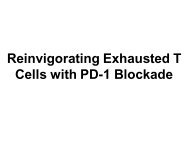
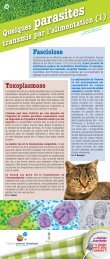

![Download presentation [1.5 Mo PDF] - GLOBE Network](https://img.yumpu.com/46262019/1/190x134/download-presentation-15-mo-pdf-globe-network.jpg?quality=85)
![Download presentation [75.75 Ko PDF] - GLOBE Network](https://img.yumpu.com/41976455/1/190x245/download-presentation-7575-ko-pdf-globe-network.jpg?quality=85)



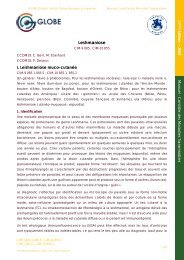
![Download presentation [160.19 Ko PDF] - GLOBE Network](https://img.yumpu.com/36251372/1/190x245/download-presentation-16019-ko-pdf-globe-network.jpg?quality=85)
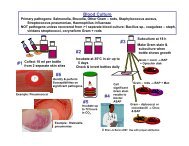
![Presentation [4.79 Mb PDF] - GLOBE Network](https://img.yumpu.com/32872413/1/190x146/presentation-479-mb-pdf-globe-network.jpg?quality=85)

